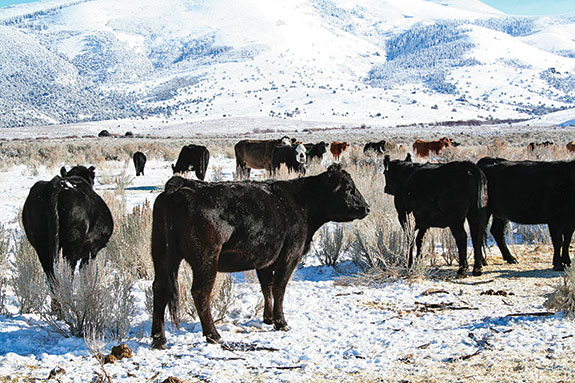Two factors often overlooked in winter are the weather and its effect on the cows’ nutrient requirements and proper ventilation in barns.
Cattle are most comfortable and perform best within the thermoneutral zone, where the ambient temperature is neither too hot nor too cold.
The low end of this zone, known as the lower critical temperature, is the point when the animal requires additional energy to maintain its body temperature.
This lower critical temperature is approximately 32 degrees F for cows with a dry winter hair coat.
Cold weather, energy and protein
As a general rule, cattle will experience a 1 percent increase in their energy requirement for each degree the effective ambient temperature, or wind chill, drops below 32 degrees F.
In other words, if the wind chill is 10 degrees F, a cow’s energy requirement would increase by 22 percent (32 minus 10).
Adding to the challenge, a wet hair coat (caused by snow, rain, sleet or high humidity in a barn) can cause the lower critical temperature to increase to 60 degrees F, which means the cow’s requirements will begin increasing as soon as the wind chill drops below this point.
In addition, a wet coat causes the amount of additional energy required per degree of temperature change to double from one degree to two degrees.
So with a wet coat of winter hair, a cow’s body will require a 2 percent increase in dietary energy for every one degree of wind chill below 60 degrees F.
Producers should compensate for the increased energy requirements by increasing the amount of dietary energy available to cattle during cold weather.
The surest way to increase energy is to add grain to the diet. However, a more subtle approach that can be effective for cattle on high-roughage diets is to save the best-quality forage for colder weather.
While this may not account for the entire increase in an animal’s requirements, it will certainly provide a portion of the added nutrients.
Protein requirements do not increase in the same manner as energy requirements when temperatures drop below the thermoneutral zone.
However, protein is still important during the winter months.

Protection from elements
In addition to its normal role within the body, adequate protein intake is essential for rumen microbes to extract energy from forages.
Therefore, protein deficiencies could lead to reduced fiber digestion and even greater energy deficiencies during adverse weather conditions.
In addition to increasing dietary energy to meet increased requirements, another consideration for beef producers during winter relates to protecting cattle from adverse weather conditions.
But placing too much emphasis on air temperature at the expense of air quality may be detrimental to the health of the animals.
Without adequate air exchange, ammonia gases have no way to escape. High levels of ammonia can lead to poor animal performance, lower general health and more smell.
In addition to ammonia, poor ventilation will also cause higher humidity in barns. As the warm, humid air rises, the moisture will condense on cooler surfaces like the roof, floor or the animals’ backs.
This condensation contributes to a wet environment, which will lead to significant increases in maintenance energy requirements, as discussed earlier.
Poor ventilation and a wet environment within a building can have other negative effects, including poor animal performance, increased incidence of respiratory illnesses, increased bedding usage, dirtier animals, slippery surfaces and the like.
Fixing the elements
One common way to provide adequate ventilation is with an open ridge at the peak of the roof.
This opening allows the hot, moist air to rise up and out of the barn, keeping the air inside the barn drier.
The same concept applies to a monoslope building, and it is usually advised to leave air inlets at least partially open year-round.
Often, curtains on these monoslope barns are only closed in times of high wind, rain or falling snow.
There is no simple answer when it comes to cold-weather ventilation, and there are many ways to provide air exchange in a building while eliminating cold drafts directly on the animals.
The easiest way to accomplish this depends on the style of building and the stocking rate of the animals.
However, no matter what the situation, it is often more important to minimize humidity than to maximize the temperature within a barn.
So, consider the effects of the cold temperatures this winter. Compensate for cold temperatures with additional dietary energy.
Also, take steps to protect cattle from the elements, but not at the expense of air quality.
For producers looking for help in formulating beef cattle rations, the University of Minnesota Extension Beef Team has created two computer programs and both include adjustment factors for ambient temperature.
The U of M Beef Cow Ration Balancer and the U of M Feedlot Ration Balancer are available for download at no charge at in the “hot topics” section. ![]()
This originally appeared in the Farm & Ranch Guide.
PHOTOS
TOP: A wet coat causes a cow’s body to require a 2 percent increase in dietary energy during periods of cold weather.
BOTTOM: Cattle are most comfortable and perform best within the thermoneutral zone, where the ambient temperature is neither too hot nor too cold. Photos courtesy of Progressive Cattleman staff.
Mike Boersma
Extension Educator
University of Minnesota








